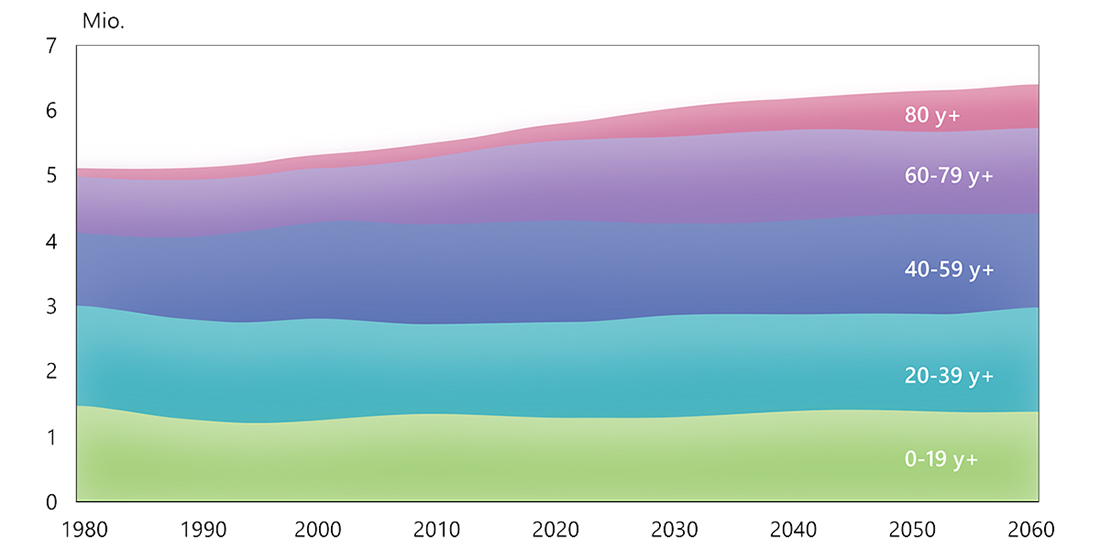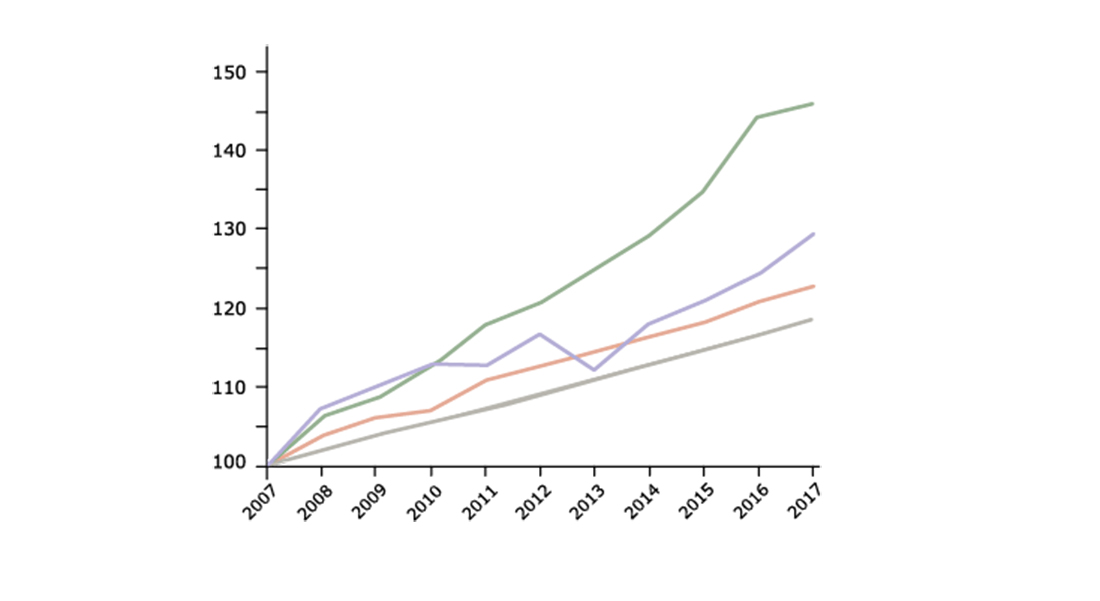Research in Project FOREVER
Visual impairment and blindness significantly reduce quality of life and increase the overall health care costs. Due to the increasing age of the population, the incidence of visual impairment is expected to rise.
Through a collaboration with Synoptik A/S, comprehensive data from extensive routine eye examinations, questionnaires, and blood pressure measurements will be linked to genetic information (saliva samples) and data from the Danish National Health Registries.
The project is a unique opportunity to study and improve the overall eye health as well as the general health of the Danish population.
Background
Visual disability is strongly associated with increasing age. Thus, as the excepted lifetime of the Danish population is increasing, the number of visually impaired persons are expected to rise as well (figure 1). People with a visual impairment suffer from low quality of life. In addition, the costs of caring for the visually impaired will increase correspondingly in a larger visually impaired population. Being able to identify persons, who are at risk of developing visual disability is crucial for both patients and society. If more risk factors could be identified, the prevention of sight-threatening diseases might be improved significantly and reduce the health care-related costs.

Figure 1: The increase in the Danish elderly population divided into 20-year segments.

Figure 2: The population growth of patients >60 years (grey line) is shown along with the number of visits to eye doctors (green), ear-nose-and-throat specialists (blue), and the general practitioners (orange line) in the years from 2007 to 2017. Source: Statistics Denmark.
Within the latest years, optician chains have offered eye health checks. The involvement of opticians provides a unique opportunity to capture and evaluate eye conditions and identify predictors and risk factors of both eyes and systemic diseases (diseases affecting the whole body) in a high volume of middle-aged to elderly people. Since August 2018, Synoptik A/S has routinely offered a comprehensive eye examination. The examination includes measurements of refraction, intraocular pressure, corneal thickness, visual acuity testing, perimetry screening, and fundus photographs. Most customers who visit Synoptik A/S are healthy, but about five percent is reported to have abnormal findings. Before August 2018, more than 30,000 customers completed a full eye examination in Synoptik A/S, and since then the yearly number has exceeded 150,000.
When experiencing decreased visual acuity, people tend to consult an ophthalmologist. However, asymptomatic sight-threatening conditions frequently remain unrecognised until advanced stages. The far most common asymptomatic eye condition is glaucoma. It is estimated that 50% of glaucoma patients are unrecognised and have not been diagnosed yet. 3.5% of the Danish population above the age of 50 are diagnosed with glaucoma. When unrecognised cases are taken into account, the number of glaucoma patients probably exceeds 5%. Although some people may be wrongly diagnosed with glaucoma without meeting the criteria for the diagnosis, the true number of glaucoma patients in the Danish population over the age of 50 probably exceeds 5%.
Age and elevated intraocular pressure are significant risk factors of glaucoma. However, despite current treatments that aim to lower the intraocular pressure, many glaucoma patients still go blind. Diagnostic delay is the most common reason for vision loss concerning glaucoma patients. Thus, predictors of disease and early diagnosis will in most cases prevent visual disability. Several studies have shown that a thorough eye examination including fundus photo and OCT, along with thorough lifestyle and health questionnaires, blood pressure measurements and collection of biological samples, can predict systemic diseases such as diabetes and hypertension.
With the possibility to link data from Synoptik A/S to the national health registries, we can retrieve additional information on various health outcomes and important co-factors such as mortality, hospital admissions, education, income, medicine, primary care data etc. Altogether, the comprehensive data will provide a unique opportunity to shed light on the aetiology of eye diseases and their interplay with common complex systemic diseases.
AIMS
- To identify risk factors and predictors of visual disability. Thus, enables us to target those at high risk of developing sight-threatening eye diseases and thereby prevent the increasing burden of blindness.
- To identify risk factors of systemic conditions to prevent life-threatening diseases and to increase the quality of life in the Danish population and worldwide.
- To validate the current eye health check in Synoptik A/S to optimise their collaboration with ophthalmologists in Denmark in the fight against sight-threatening eye diseases.
HOW
Data will be collected from at least 30,000 invited Synoptik A/S customers, who have all undergone a full eye examination three years prior in a Synoptik A/S store. The customers must provide a saliva sample and the optician will measure refraction, visual acuity, intraocular pressure, corneal thickness, perimetry, and lastly take a fundus image. Moreover, the optician will measure blood pressure. Roughly 10,000 will be offered an OCT scan of the optic nerve head and the macula additionally to the other examinations.
In addition to the above-mentioned population, approximately 250,000 customers above 18 years of age as possible will be collected. Eye exams will consist of measurements of refraction, visual acuity, intraocular pressure, corneal thickness, fundus images, and perimetry.
Furthermore, both populations must respond to a questionnaire regarding smoking, alcohol consumption, physical exercise, mental wellbeing, and known family diseases.
The Steering Committee
Professor, Chief Physician Miriam Kolko, Copenhagen University Hospital Rigshospitalet-Glostrup & University of Copenhagen
Professor, Chief Physician Christian Torp-Pedersen, Nordsjællands Hospital
Professor, Chief Physician Marianne Benn, Copenhagen University Hospital Rigshospitalet-Glostrup & University of Copenhagen
Professor, Programme Director Søren Brunak, University of Copenhagen
Professor, Chief Physician Morten Dornonville de la Cour, Copenhagen University Hospital Rigshospitalet-Glostrup & University of Copenhagen
Head of Clinical Development Annette Slyngborg, Synoptik A/S
The Junior Partners
Postdoc Anne Pernille Toft Petersen
Associate Professor Karina Banasik
Postdoc, Research Leader Kristoffer Sølvsten Burgdorf
Senior Registrar Dorte Nellemann Thornit, Copenhagen University Hospital Rigshospitalet-Glostrup
PhD Candidates
Jens Rovelt Andreasen, University of Copenhagen
Josefine Clement Freiberg, University of Copenhagen
International Advisory Board
Professor, Consultant Paul Foster, UCL Institute of Ophthalmology
Professor, Director Gus Gazzard, Moorfields Eye Hospital, London & UCL
Professor David Crabb, City University of London
Consultant Ananth Viswanathan, Moorfields Eye Hospital, London
Professor Sarah Barman, Kingston University
Professor, Deputy Institute Director Christopher Owen, St George’s, University of London
Professor Alicja Rudnicka, St George’s, University of London
Funding:

